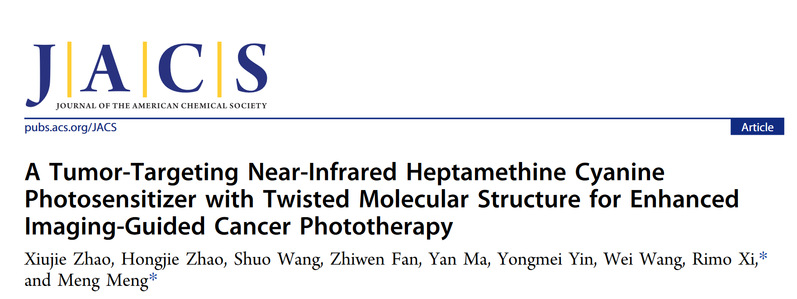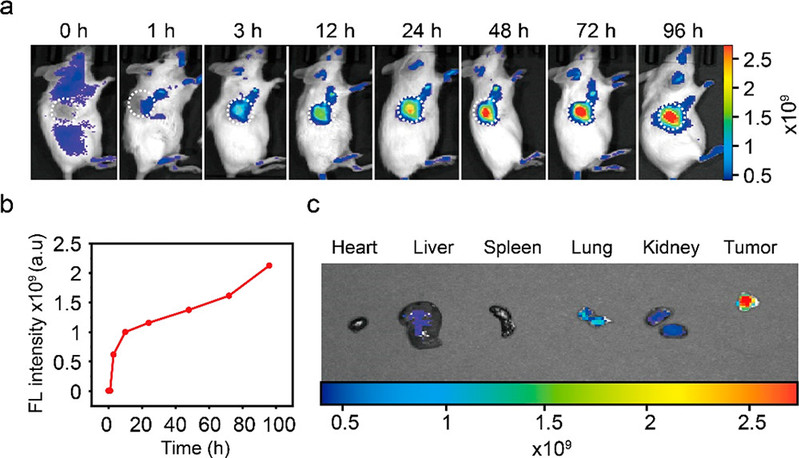Nankai Team has Scored New Achievements in the Research Field of Tumor-targeting Near-infrared Photosensitizer
Recently, the research team led by Professor Rimo Xi and Associate Professor Meng Meng from the College of Pharmacy of Nankai University published a paper entitled “A Tumor-Targeting Near-Infrared Heptamethine Cyanine Photosensitizer with Twisted Molecular Structure for Enhanced Imaging-Guided Cancer Phototherapy” in “J. Am. Chem. Soc.” , an internationally renowned academic journal. The research team has designed and synthesized a tumor-targeting near-infrared photosensitizer T780T: The twisted structure of tetraphenylethylene (TPE) is introduced between two molecules cyanine photosensitizer IR780 to enhance the photothermal conversion efficiency and photostability. The constructed molecule T780T could self-assemble into uniform nanoaggregates in aqueous phase. After caudal vein injection in tumor-bearing mice, T780T aggregates show obvious tumor accumulation effect, and more significant tumor inhibition effect is achieved after one dose and two laser irradiations therapy method.


Schematic diagram for T780T structure and tumor-targeting phototherapy
Heptamethine cyanine IR780, under the excitation of near-infrared light (808 nm), can simultaneously produce PTT and PDT effects. It can target tumor cells through the high expression of organic anion transporting polypeptides (OATPs) mediates in cancer cells. In view of IR780's poor photostability and low photothermal conversion efficiency, the chlorine atom in IR780 structure is replaced by tetraphenylethylene, and two molecules IR780 are coupled to obtain T780T molecule. The twisted structure of tetraphenylethylene can not only promote the intramolecular movement of the excited state to enhance the photothermal effect, but also facilitate the loose accumulation of T780T. The molecule exhibits strong near-infrared fluorescence and photothermal conversion efficiency (PCE=38.5%) in the dispersed state. In aqueous phase, T780T can self-assemble into uniform nanoaggregates (size about 200nm). At this time, the fluorescence and PTT response are extremely low, which can effectively reduce the fluorescence interference and PTT side effects in vivo imaging in normal tissues. After intravenous injection into tumor-bearing mice, it is found that T780T nanoaggregates show good photostability and have obvious long-term (96h) tumor tracing effects. T780T's excellent photostability enables it to be irradiated twice after a single dose, thus revealing more significant photothermal and tumor inhibition effects.

Real-time fluorescence imaging (a, b) of tumor-bearing mice intravenously injected with T780T nanoaggregates (100μM, 100μL) and tissue distribution (c) 24h after administration (Ex=745nm; Em=800nm)

PTT–PDT synergistic therapy for tumor-bearing mice intravenously injected with T780T nanoaggregates and the variation trend of tumor temperature (808nm, 0.8wcm−2)
In conclusion, the T780T molecular design method built in this research is simple. The tetraphenylethylene introduction significantly improves the photostability and photothermal conversion efficiency, while retaining the IR780 inherent tumor targeting, helping to achieve efficient cancer photodynamic therapy, providing a new design strategy for heptamethine cyanine photosensitizer with clinical application potentiality.
The first author of this paper is Zhao Xiujie, a post doctorate of the Collage of Pharmacy of Nankai University, Professor Rimo Xi and Associate Professor Meng Meng of the Collage of Pharmacy Nankai University are co-corresponding authors, and Nankai University is the first complete unit.
This research has been supported by National Natural Science Foundation of China, the Department of International Cooperation of the Ministry of Science and Technology, and Tianjin Science and Technology Project.
View full text: https://pubs.acs.org/doi/10.1021/jacs.1c09155
(Edited and translated by Nankai News Team.edited and translated by Nankai News Team)









